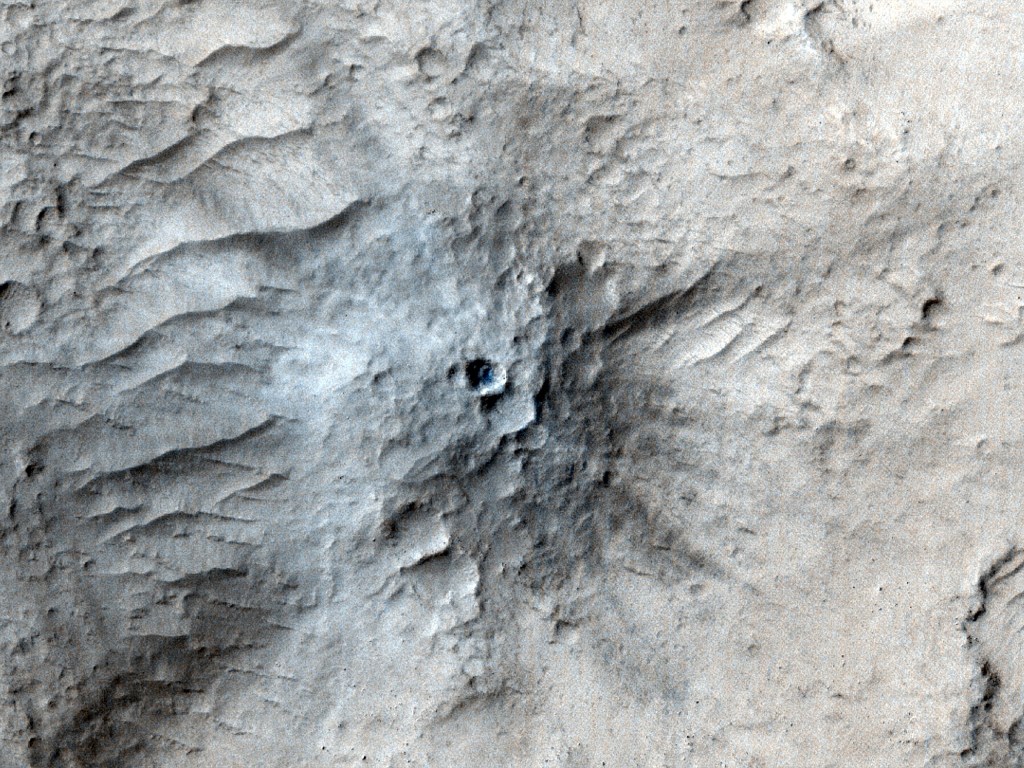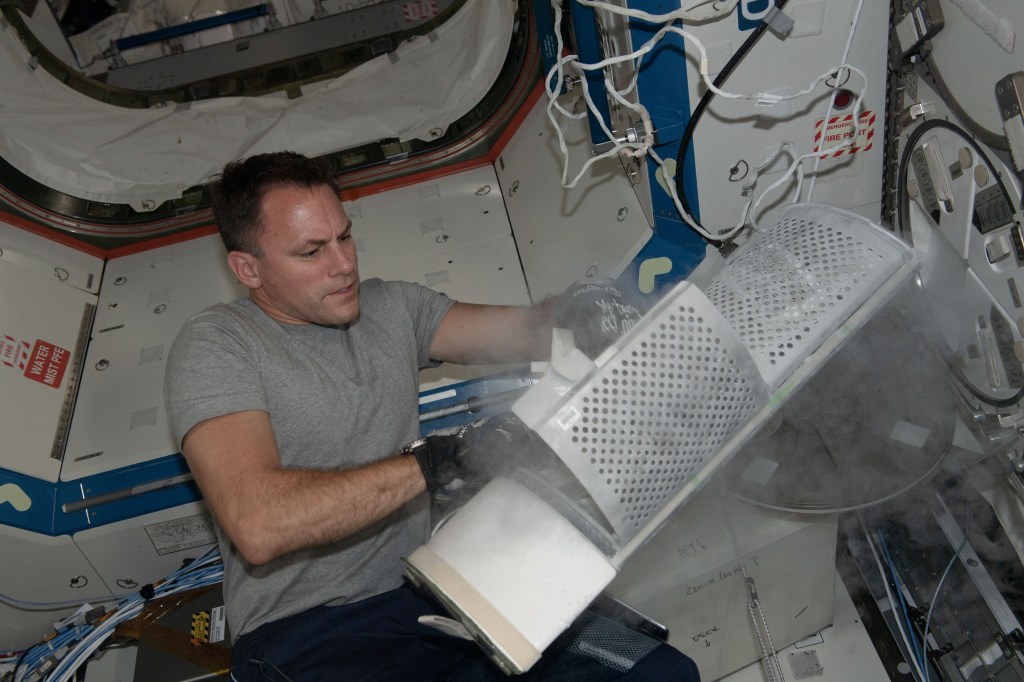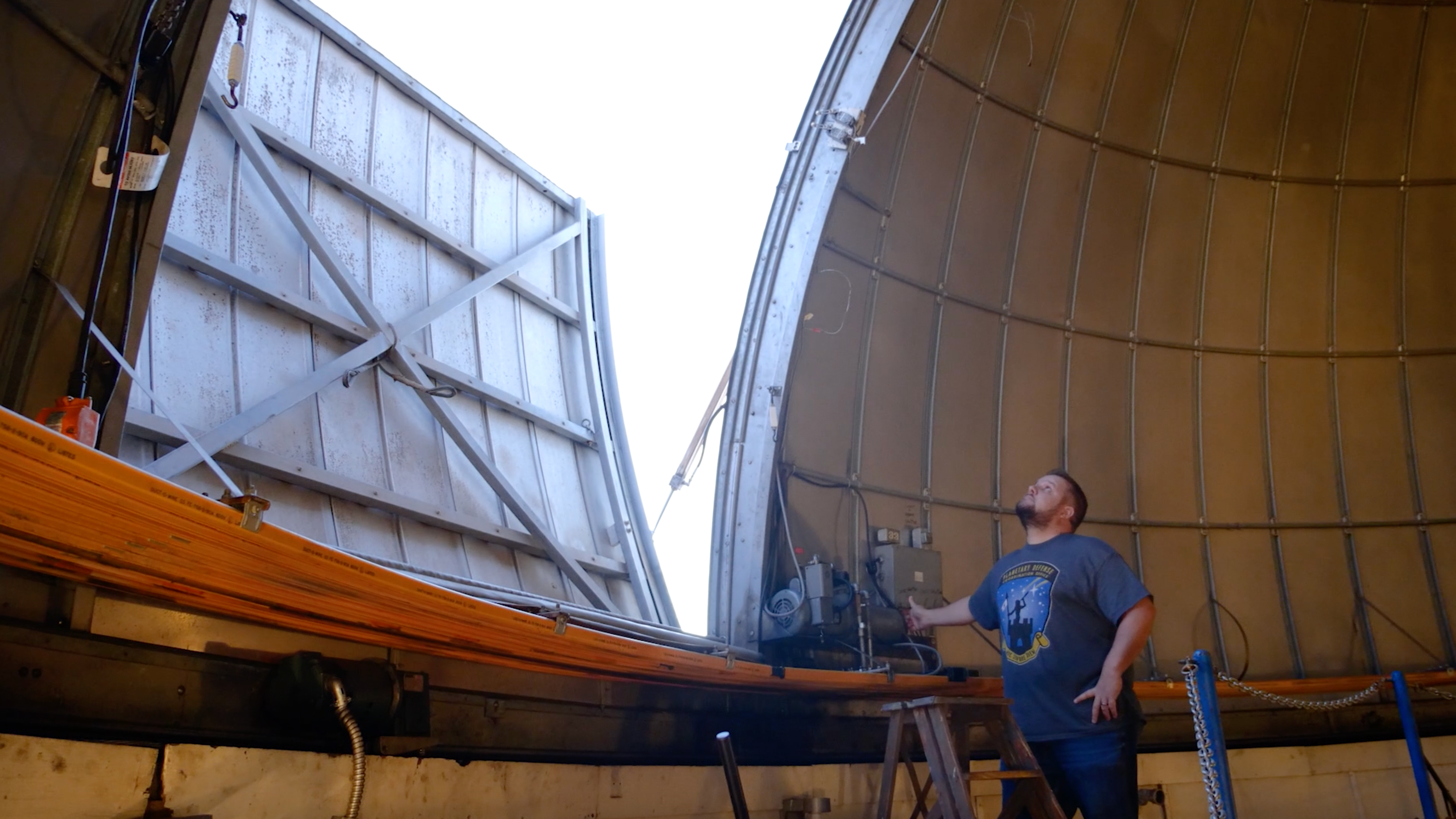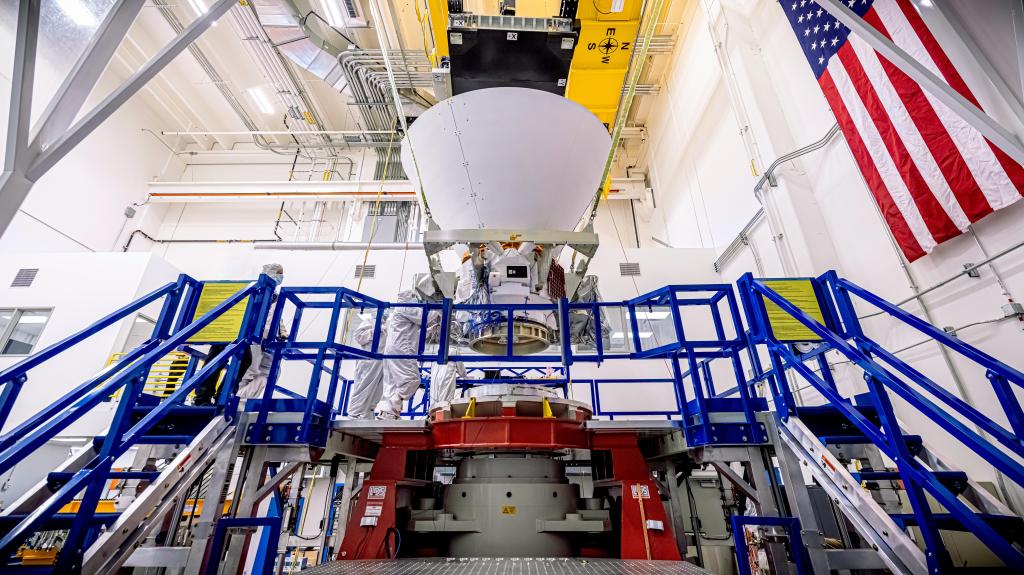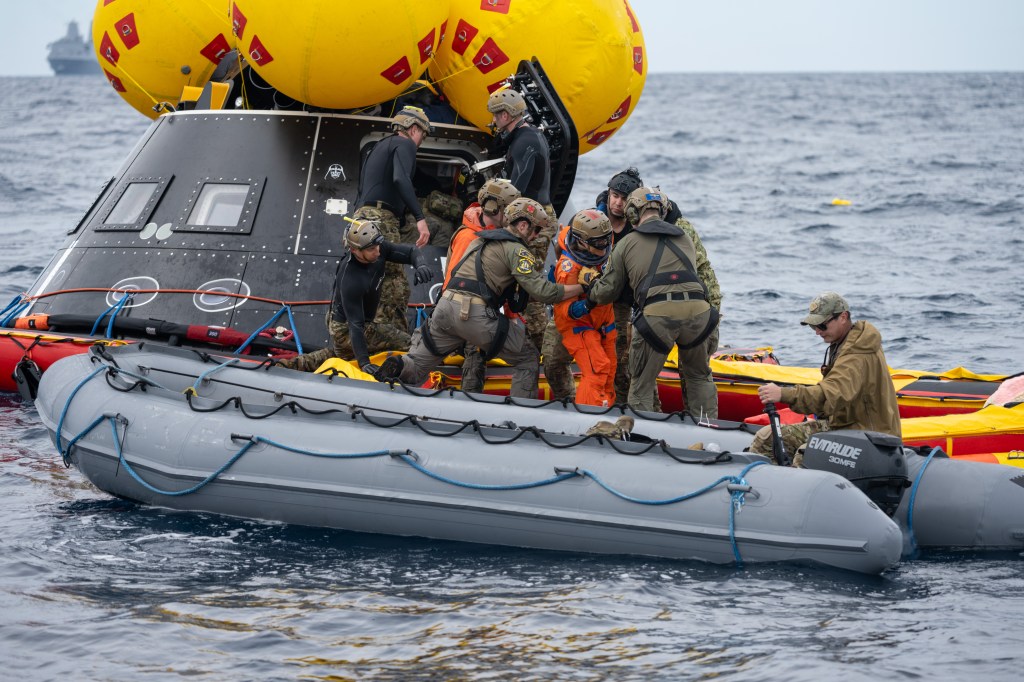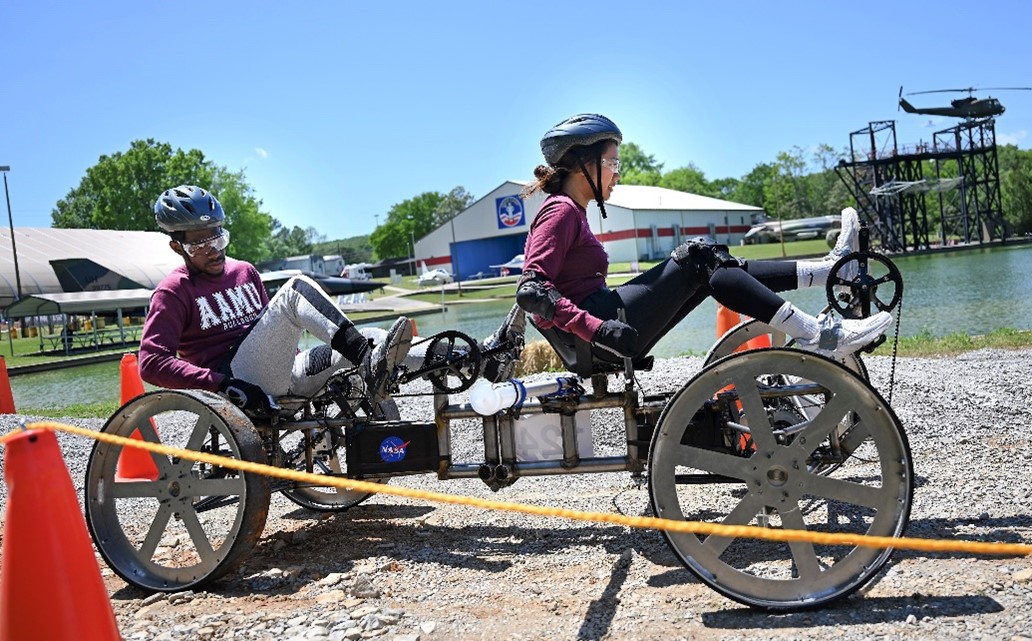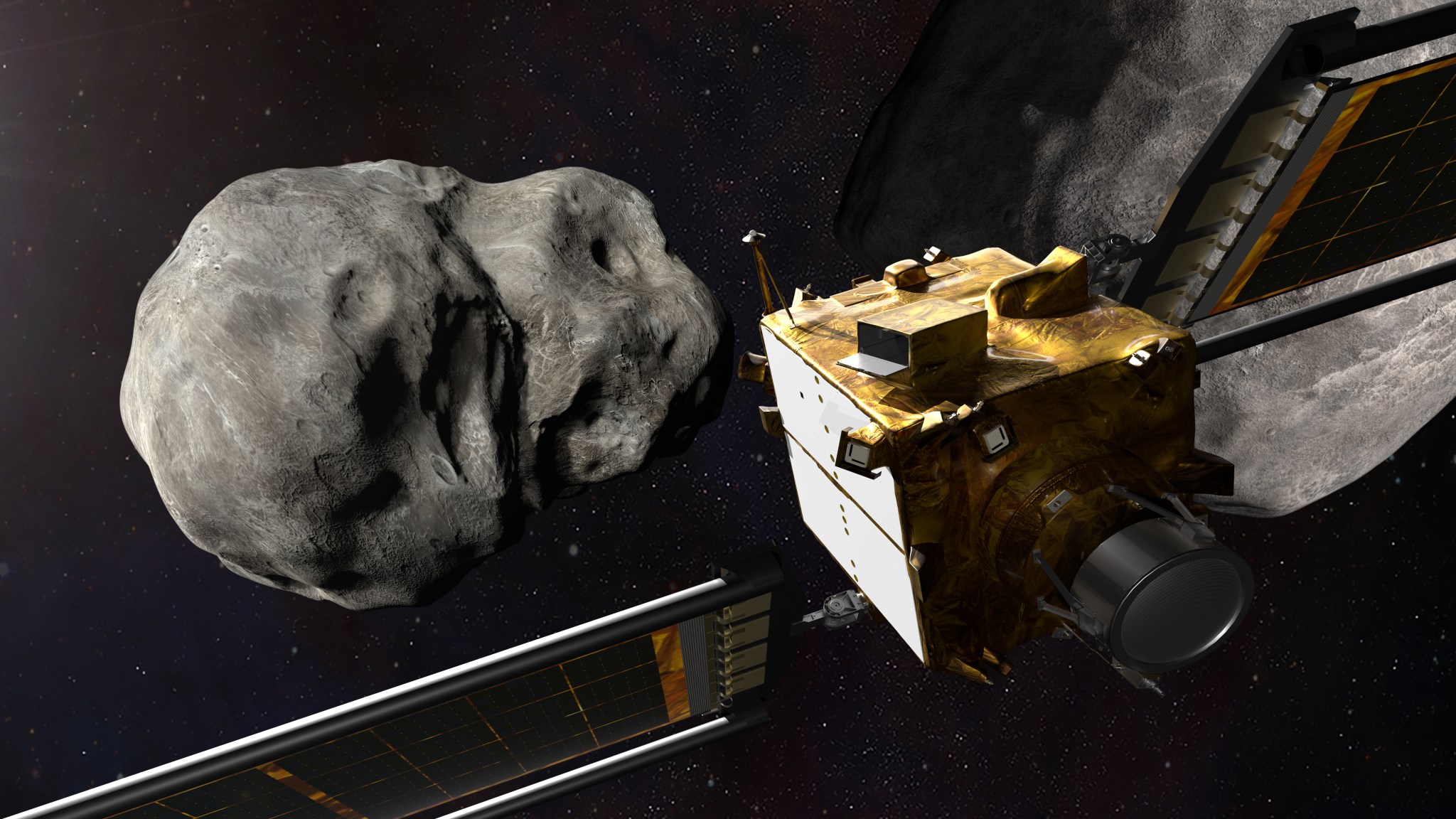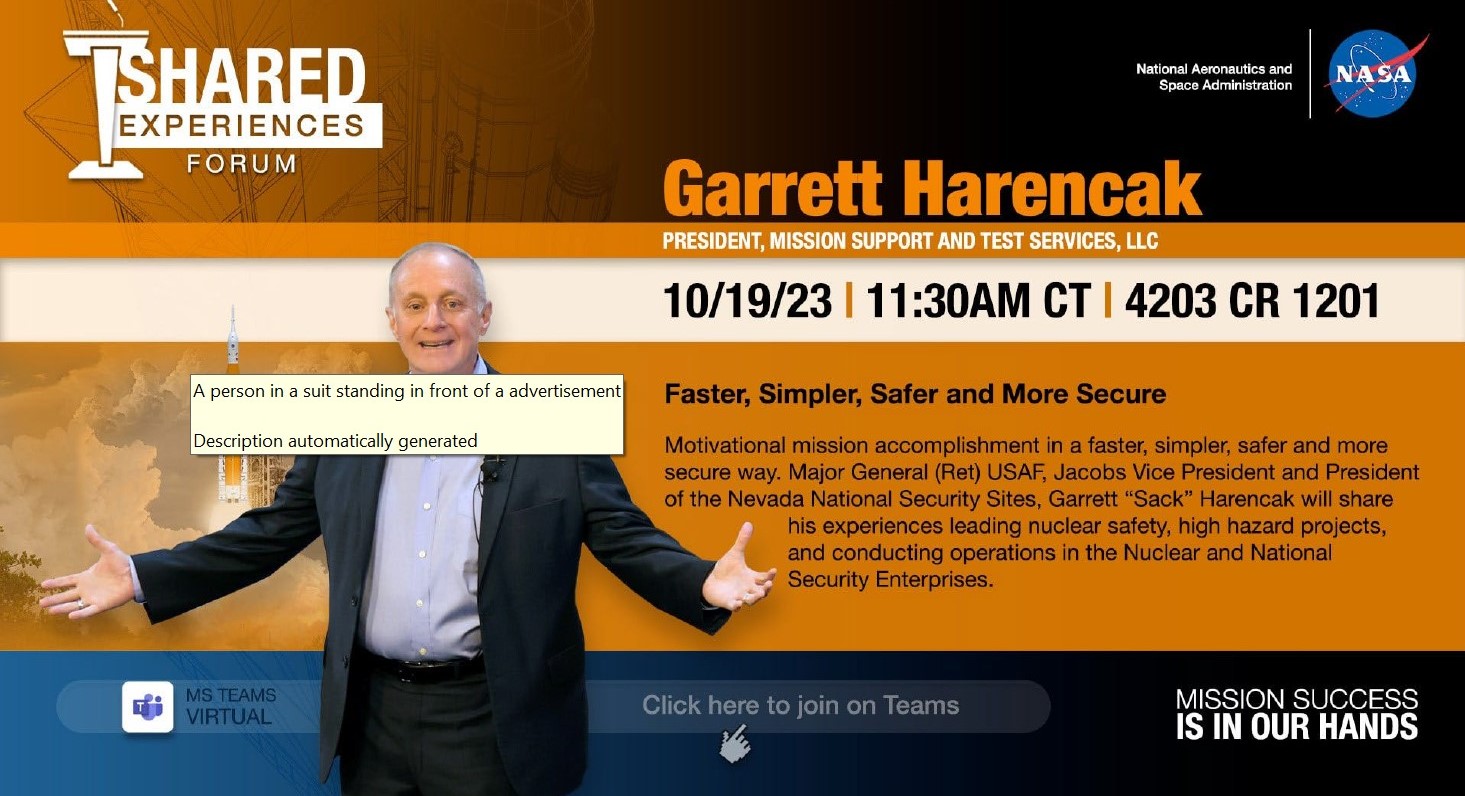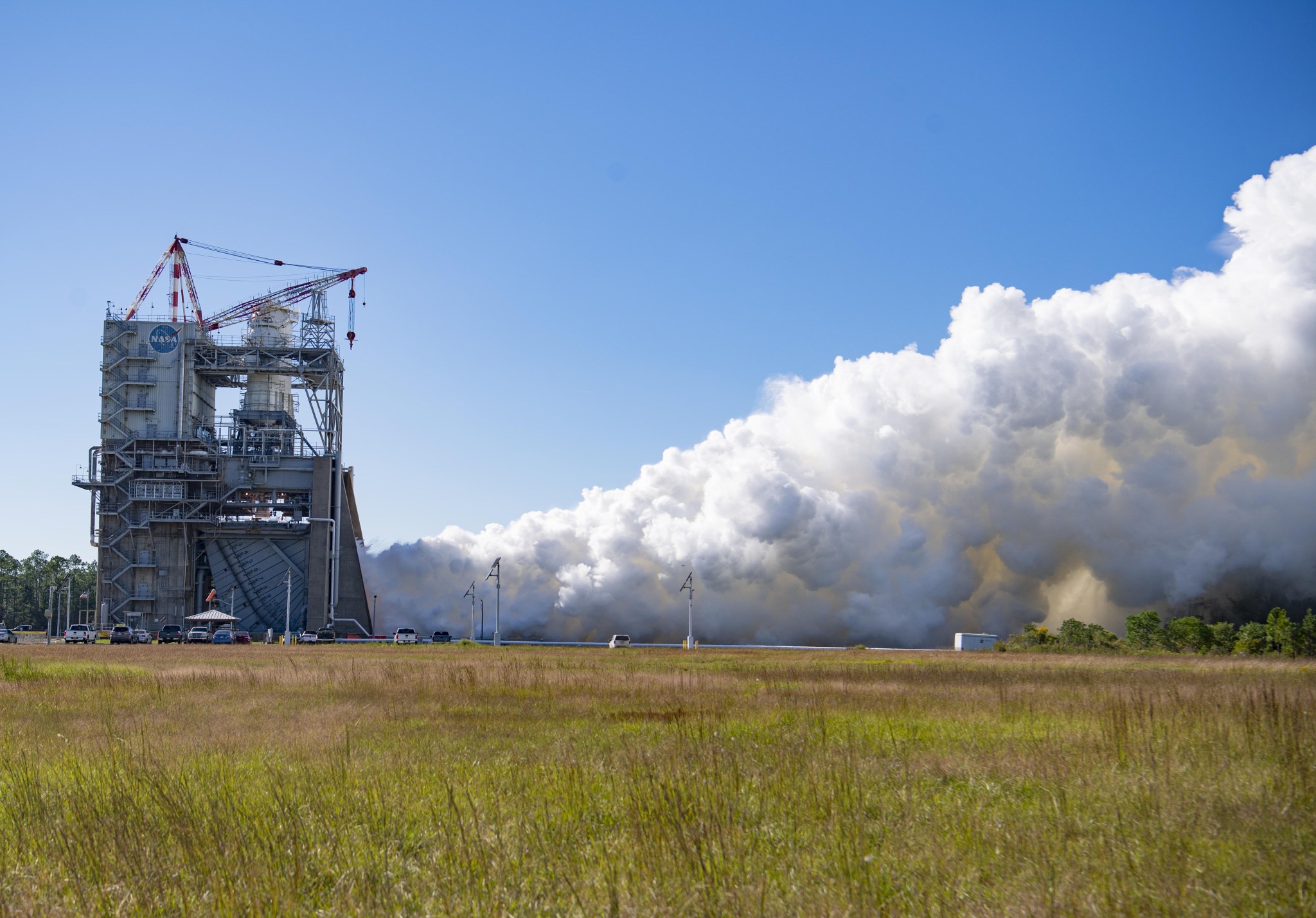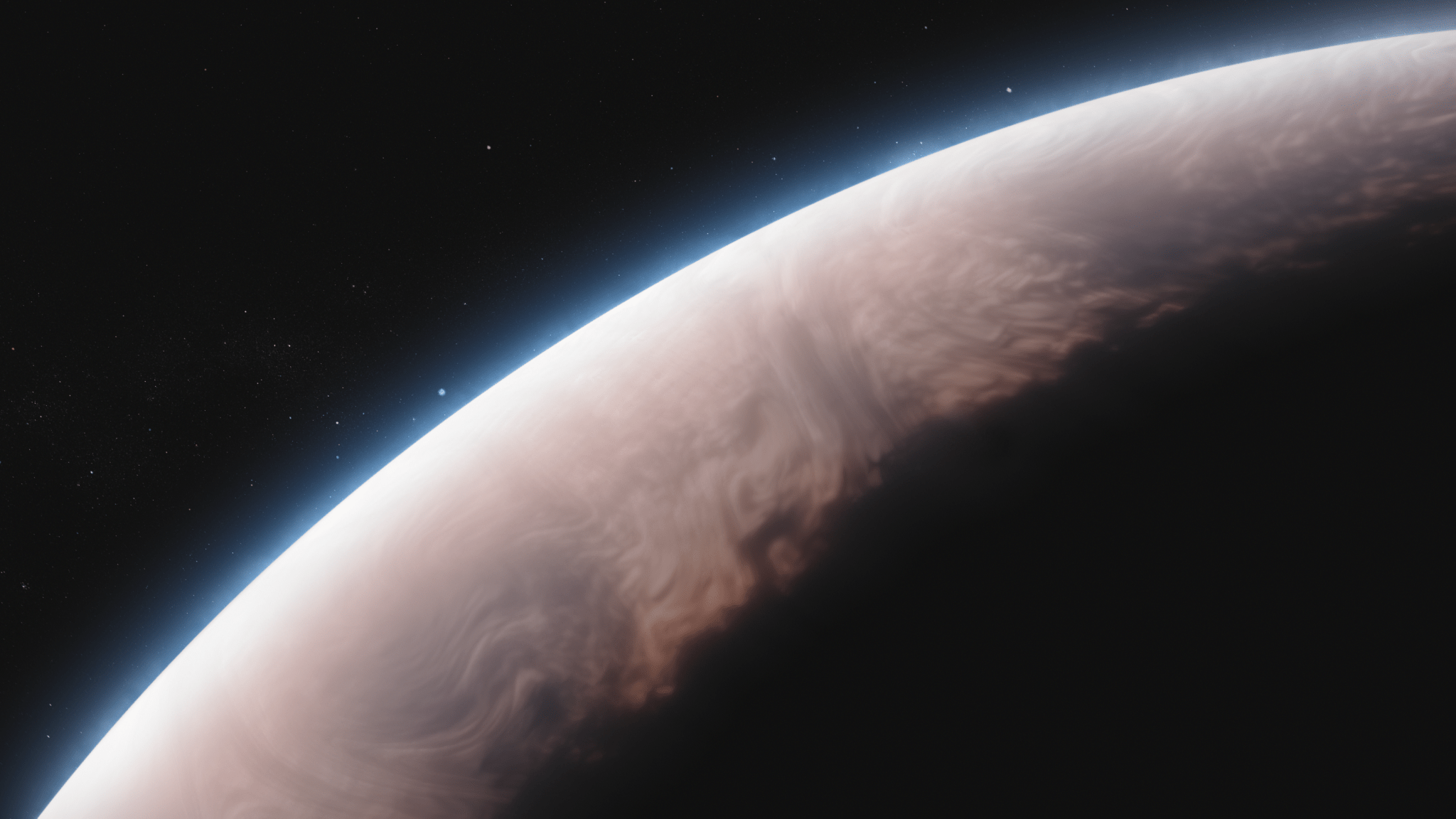Marshall Managers Win Top Federal Award for DART Asteroid Deflection Mission
By Rick Smith
Brian Key and Scott Bellamy of NASA’s Marshall Space Flight Center accepted the Samuel J. Heyman Service to America Medals, presented by Partnership for Public Service Oct. 17 during a ceremony at the John F. Kennedy Center for Performing Arts in Washington.
The awards program for career federal employees, known as the Sammies, aims to highlight key accomplishments that benefit the nation, seeks to build trust in government, and inspire people to consider careers in public service.
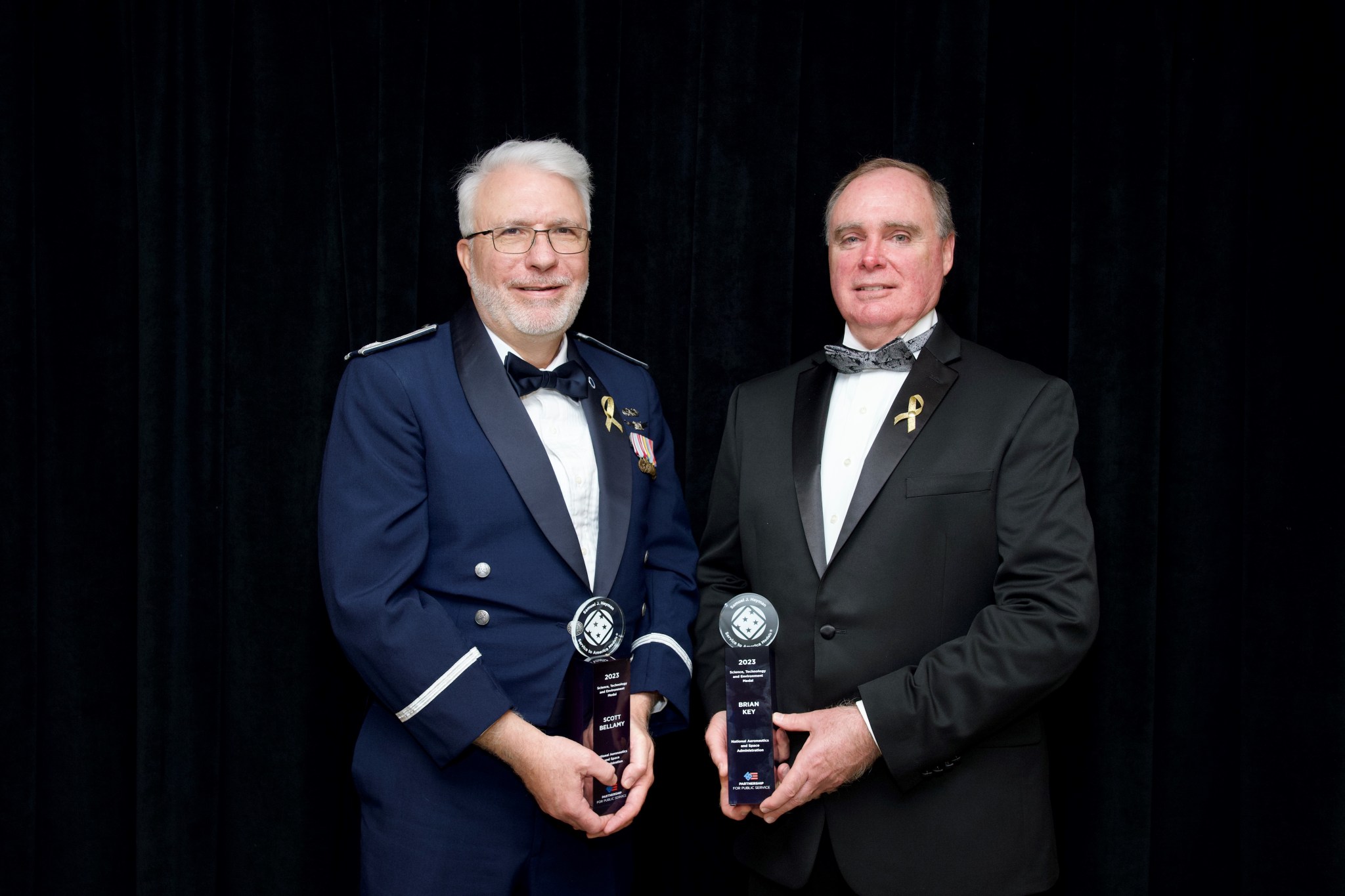
Key and Bellamy led NASA’s DART (Double Asteroid Redirection Test) team, which successfully altered the orbit of an asteroid in September 2022, providing the first-ever planetary defense test capable of protecting Earth from celestial threats.
As part of the PMPO (Planetary Missions Program Office) at Marshall, Key and Bellamy served as program manager and mission manager, respectively, for DART. For their work on the mission, the duo was honored in the Science, Technology, and Environment category of the Sammie awards.
“DART was a first-of-its-kind mission that marked a watershed moment for planetary defense. The DART team members are some of the very best of NASA, and we are so excited to see Brian Key and Scott Bellamy recognized for their contributions and leadership,” NASA Administrator Bill Nelson said. “Brian, Scott, and the entire DART team have shaped the course of human space exploration, inspiring people around the world through innovation. Thanks to their dedication and hard work, NASA is better prepared to defend our home planet, and will be ready for whatever the universe throws at us.”
In his role on DART, Key maintained budget, staff, and schedule oversight for the mission and worked directly with DART spacecraft developers at Johns Hopkins University Applied Physics Laboratory in Laurel, Maryland.
“I’m elated to see our team honored with this award, and hope it will bring more attention to the valuable work NASA does to protect our home world,” said Key, who as program manager oversees NASA’s science exploration portfolio spanning the Discovery Program, the New Horizons Program, and the Solar System Exploration Program, which covers the full range of large and small science missions exploring the solar system, planets, and other targets of interest.
Bellamy was tasked with keeping the team on track to launch and execute the mission – echoed Key’s praise for the entire DART team.
“We’re just the managers,” he said. “Our role has been to serve the team, keeping things moving forward as smoothly as possible to enable them to do the actual hands-on, pencil-to-hardware that brought this mission from concept to reality.”
That mission could not have gone more flawlessly, they agreed. Launched in November 2021, the DART spacecraft traveled to more than 6.8 million miles from Earth with one simple goal: to intentionally impact into Dimorphos, a 492-foot-diameter asteroid, at roughly 14,000 miles per hour, thus altering its orbit around its much larger parent asteroid, Didymos. DART’s collision with Dimorphos altered the asteroid’s roughly 12-hour orbit period around its parent by about a half-hour.
“I don’t even have the words to describe the release of emotion in the control room when we got confirmation that DART had impacted,” Bellamy said. “The whole team went from nail-biting suspense to unbelievable excitement in a matter of seconds.”
Neither Key, Bellamy, nor the Planetary Missions Program Office is resting on these newly acquired laurels.
Key continues to serve as program manager on NASA’s Juno mission, which since its arrival at Jupiter in 2016 has sought new clues about the gas giant’s evolution and role in the formation of our solar system. He’s also program manager for NASA’s Psyche mission, launched Oct. 13 to begin a six-year journey to study a metal-rich asteroid of the same name in solar orbit between Mars and Jupiter.
Bellamy, meanwhile, is mission manager for NASA’s Lucy mission, which over a 12-year period will tour the asteroid belt between Mars and Jupiter and closely study seven Jovian asteroids. Launched in 2021, Lucy will be the first spacecraft ever to return to Earth from the outer solar system. Bellamy also leads development of NASA’s Europa Clipper mission, which could launch in late 2024 to fly to Jupiter’s moon and conduct an intensive survey of the potentially life-sustaining seas beneath Europa’s icy surface.
As for future planetary defense activities, NASA and its partners will build on DART’s success. A follow-up mission by ESA (European Space Agency), called Hera, is scheduled to launch in 2024 to further assess DART’s impact on Dimorphos. NASA also is developing the NEO Surveyor mission, which is designed to accelerate the rate at which the agency can discovery potentially hazardous near-Earth objects, asteroids and comets which can come close to Earth and could pose an impact risk.
“Even small asteroids could do a tremendous amount of damage to a city or metropolitan area,” Key said. “We need to be more aware of the very real threat they pose and develop the means to avoid calamity.”
Johns Hopkins Applied Physics Laboratory managed the DART mission for NASA’s Planetary Defense Coordination Office. The agency provided support for the mission from several centers, including the Jet Propulsion Laboratory, Goddard Space Flight Center, Johnson Space Center, Glenn Research Center, and Langley Research Center.
Created in 2002, the Samuel J. Heyman Service to America Medals, named for the organization’s late founder, recognize excellence and leadership in the federal government. Presented annually by the nonprofit Partnership for Public Service, the awards honor public servants whose significant achievements help the nation innovate, engage globally, and deliver vital services to the public. Learn more about the awards.
Smith, a Manufacturing Technical Solutions employee, supports Marshall’s Office of Communications.
Mission Success is in Our Hands to Showcase New Look at Oct. 19 Event
By Wayne Smith
An initiative highlighting mission success and the safety culture at NASA’s Marshall Space Flight Center will showcase a new look at its Oct. 19 event.
Mission Success is in Our Hands is a safety initiative collaboration between NASA’s Marshall Space Flight Center and Jacobs Engineering. As part of the final Shared Experiences Forum of the year, the Mission Success committee will display eight new testimonial banners featuring Marshall team members as part of its rebranding. The banners will be placed across the center.
Garrett Harencak, Jacobs Engineering vice president and president of Mission Support and Test Services LLC, will be the Mission Success is in Our Hands hybrid Shared Experiences Forum speaker from 11:30 a.m. to 1 p.m. Oct. 19. Marshall team members are encouraged to attend the meeting in Building 4203, Room 1201. Light refreshments will be served. The forum is available to NASA employees and the public virtually via Teams.
Harencak will share his experiences in working and leading nuclear safety, high hazard projects, and conducting operations in the nuclear and national security industries.
“The Mission Success is in Our Hands initiative brings awareness to our workforce of the importance of their individual contributions to the overall success of the NASA and Marshall missions,” said Bill Hill, director of the Safety and Mission Assurance Directorate at Marshall. “Through our banners, the Golden Eagle award, and the Shared Experience Forum, we highlight the risk environment in which we work and in which our launch vehicles and spacecraft operate. Many Shared Experiences Forum events bring in risk practitioners from other industries to provide a comparison and illuminate lessons learned that we could gain from in our everyday activities and missions.”
Hill said Marshall has a strong safety culture. The new banners feature team members expressing that message to the workforce and they will be featured with individual profiles in upcoming editions of the Marshall Star..
“The Mission Success is in Our Hands initiative is one of the few tools that we employ at Marshall to keep Safety and Mission Success in the forefront of everyone’s mind,” Hill said. “It is important that we keep people safe at work and allow all to go home at night healthy and safe. Our Incident and Injury Free workshops, which we are soon to begin in-person sessions, offer our employees the opportunity to learn how to identify risky or unsafe behaviors and situations, and how to have those critical conversations to mitigate or eliminate those behaviors among colleagues before an incident or injury occurs.”
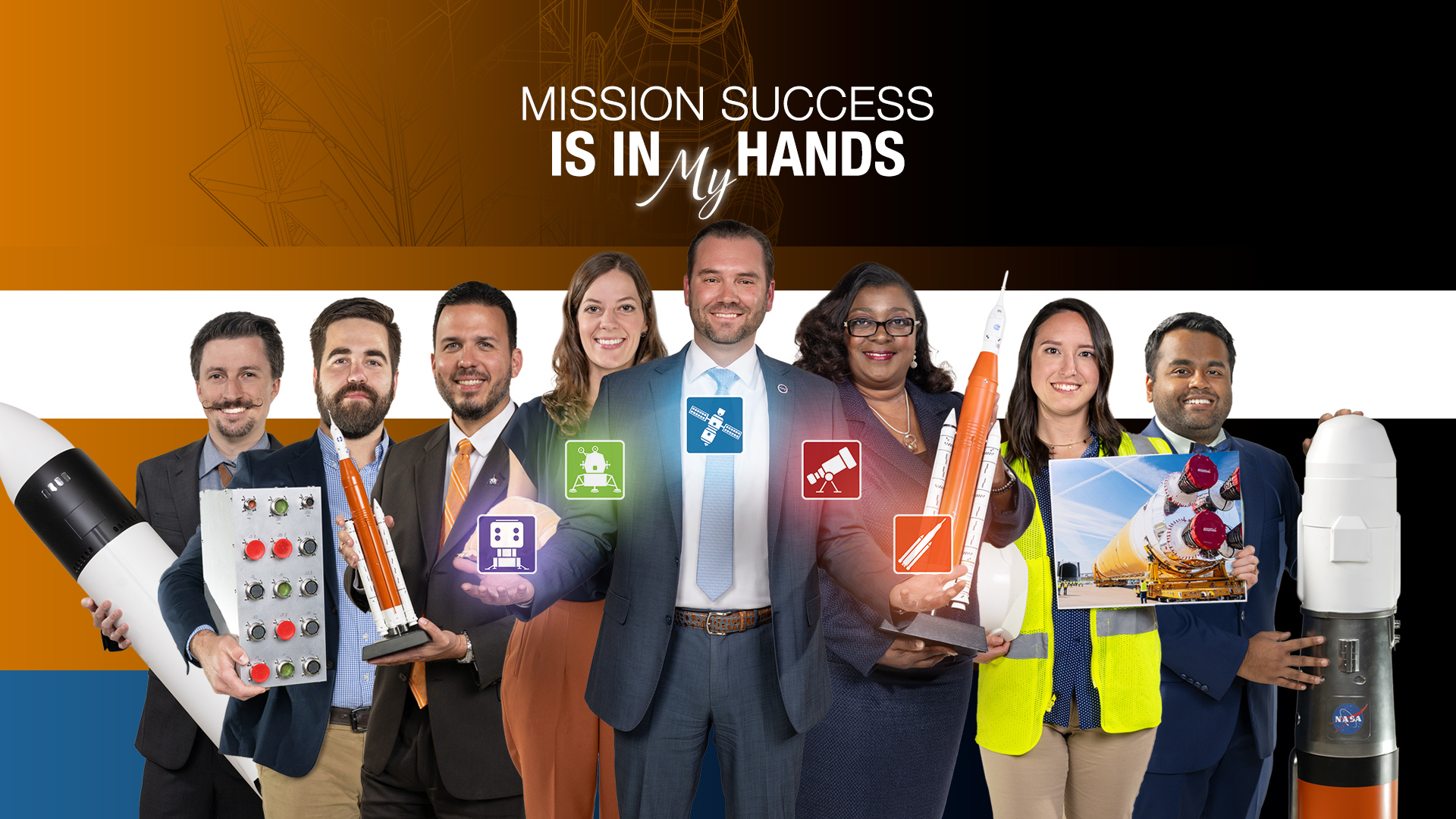
Jeff Haars, Jacobs vice president and program manager for Jacobs Space Exploration Group, said team members working on NASA missions must not lose sight of the hazards present in the workplace or the risks of crewed spaceflight.
“The Shared Experiences Forum is probably our most impactful initiative,” Haars said. “Leaders from across NASA and industry share their personal experiences around safety and mission success. The forum provides an opportunity for learning and applying lessons and best practices from personal experiences. Ultimately, our goal is to help team members keep safety and mission assurance in their day to day decision making.”
Since 2015, the Golden Eagle Award has been presented by Mission Success is in Our Hands. The award promotes awareness and appreciation for flight safety, as demonstrated through the connections between employees’ everyday work, the success of NASA and Marshall’s missions, and the safety of NASA astronauts. The award recognizes individuals who have made significant contributions to flight safety and mission assurance above and beyond their normal work requirements. Management or peers can nominate any team member for the award. Honorees are typically recognized at quarterly Shared Experiences forums.
Smith, a Media Fusion employee and the Marshall Star editor, supports the Marshall Office of Communications.
Alabama Doctors Praise ‘Unique’ NASA Panel on Aerospace Psychiatry
By Jessica Barnett
Medical professionals from across the U.S. gathered for a different kind of panel discussion during the annual Alabama Psychiatric Physicians Association’s Fall Conference held Oct. 12 at The Westin Huntsville.
The Alabama Psychiatric Physicians Association is a district branch of the American Psychiatric Association and the only association exclusively representing psychiatrists in the state of Alabama.
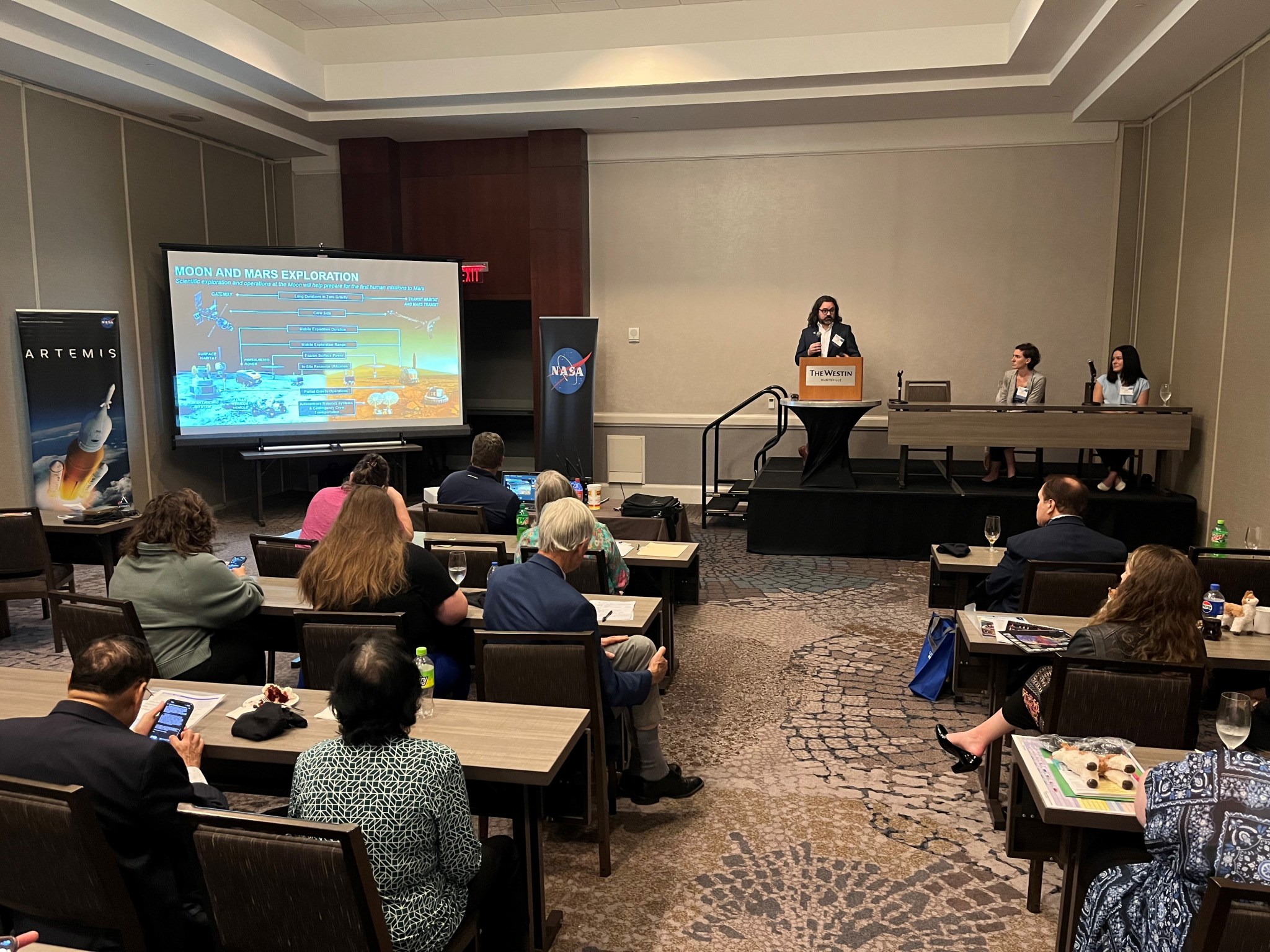
Psychiatrists were treated to a panel of NASA experts who shared insight from their work supporting human spaceflight research and habitation design for extended duration missions on the lunar and Martian surfaces. Panelists included Ian Maddox, a systems engineer supporting Artemis at NASA’s Marshall Space Flight Center; Erin Hayward, an engineer on the Marshall Space Environmental Effects team; and Julie Mason, a space propulsion and thermal engineer working on NASA’s Space Launch System with Boeing.
During the panel, Hayward and Mason shared their experiences serving as crew members in multiple NASA analog missions, including HERA (Human Exploration Research Analog) and Desert RATS. Both involve space habitat design, isolation, and confinement studies, as well as identifying if certain stressors could affect astronauts during off-world missions. Such stressors include changes to sleep patterns, food intake, gravity, exercise routines, and more.
Maddox explained that it’s part of NASA’s ongoing work to prepare for longer missions to the Moon and beyond. “Humanity has always explored, and NASA is really the organization responsible for making sure that continues to happen safely and peacefully,” he said.
Audience members were particularly interested in the analog missions, with several taking part in the Q&A portion of the panel. Many thanked the experts for presenting such a unique and fascinating topic, while some expressed interest in hosting similar discussions at future conferences across the nation.
Panelists answered questions about the crew selection process, explaining NASA’s careful screening procedures for identifying candidates to serve together for weeks or months in confined spaces and with very limited access to the outside world. Hayward and Mason also answered questions about their day-to-day lives inside the habitats, from smells and privacy concerns to handling downtime, and how it felt returning to their families and jobs after their campaigns.
“It took me a while to turn my phone notifications back on, just to ease back into the world,” Mason said. “I learned to be present and have more gratitude for the little things, like getting to feel the humidity, especially after 45 days without weather.”
The three NASA panelists encouraged audience members to submit a research proposal or even consider applying to participate in a future analog.
Barnett, a Media Fusion employee, supports the Marshall Office of Communications.
Dozens of Student Teams Worldwide to Compete in NASA Rover Challenge
NASA has selected 72 student teams to begin an engineering design challenge to build human-powered rovers that will compete next April at the U.S. Space & Rocket Center in Huntsville, near the agency’s Marshall Space Flight Center.
Celebrating its 30th anniversary in 2024, the Human Exploration Rover Challenge tasks high school, college, and university students to design, build, and test lightweight, human-powered rovers on an obstacle course simulating lunar and Martian terrain, all while completing mission-focused science tasks.
Participating teams represent 42 colleges and universities and 30 high schools from 24 states, the District of Columbia, Puerto Rico, and 13 other nations from around the world. NASA’s handbook has complete proposal guidelines and task challenges.
“Throughout this authentic learning challenge, NASA encourages students to improve their understanding of collaboration, inquiry, and problem-solving strategies,” said Vemitra Alexander, rover challenge activity lead, Office of STEM Engagement at NASA Marshall. “Improving these critical real-world skills will benefit our students throughout their academic and professional careers.”
Throughout the nine-month challenge, students will complete design and safety reviews to mirror the process used by NASA engineers and scientists. The agency also incorporates vehicle weight and size requirements encouraging students to consider lightweight construction materials and stowage efficiency to be replicate similar payload restrictions of NASA launch operations.
Teams earn points throughout the year by successfully completing design reviews and fabricating a rover capable of meeting all criteria while completing course obstacles and mission tasks. The teams with the highest number of points accumulated throughout the project year will win their respective divisions. The challenge will conclude with an event April 19 and April 20, 2024, at the U.S. Rocket and Space Center.
This competition is one of nine Artemis Student Challenges and reflects the goals of NASA’s Artemis program, which includes landing the first woman and first person of color on the Moon. It is managed by NASA’s Southeast Regional Office of STEM Engagement at Marshall. NASA uses challenges and competitions to further the agency’s goal of encouraging students to pursue degrees and careers in science, technology, engineering, and mathematics.
NASA Prepares Artemis II Moon Rocket Core Stage for Final Assembly Phase
By Megan Carter
NASA and its partners have fully secured the four RS-25 engines onto the core stage of the agency’s SLS (Space Launch System) rocket for the Artemis II flight test. The core stage, and its engines, is the backbone of the SLS mega rocket that will power the flight test, the first crewed mission to the Moon under Artemis.
Engineers have begun final integration testing at NASA’s Michoud Assembly Facility, in preparation for acceptance ahead of shipment of the stage to Kennedy Space Center in the coming months.

The 212-foot-tall core stage includes two massive liquid propellant tanks and four RS-25 engines at its base. For Artemis II, the core stage and its engines act as the powerhouse of the rocket, providing more than two million pounds of thrust for the first eight minutes of flight to send the crew of four astronauts inside NASA’s Orion spacecraft on an approximately 10-day mission around the Moon.
NASA, Aerojet Rocketdyne, an L3Harris Technologies company and the RS-25 engines lead contractor, along with Boeing, the core stage lead contractor, secured the engines to the maze of propulsion and avionics systems within the core stage Oct. 6. In the coming weeks, engineers will perform testing on the entire stage and its avionics and electrical systems, which act as the “brains” of the rocket to help control it during flight.
Once testing of the stage is complete and the hardware passes its acceptance review, the core stage will be readied for shipping to Kennedy via the agency’s Pegasus barge, based at Michoud.
As teams prepare the core stage for Artemis II, rocket hardware is also under construction on our factory floor for Artemis III, IV, and V that will help send the future Artemis astronauts to the lunar South Pole.
The engines were first soft mated one by one onto the stage beginning in early September. The last RS-25 engine was structurally installed onto the stage Sept. 20. Installing the four engines is a multi-step, collaborative process for NASA, Boeing, and Aerojet Rocketdyne.
Following the initial structural connections of the individual engines, securing and outfitting all four engines to the stage is the lengthiest part of the engine assembly process and includes securing the thrust vector control actuators, ancillary interfaces, and remaining bolts before multiple tests and checkouts.
All major hardware elements for the SLS rocket that will launch Artemis II are either complete or in progress. The major components for the rocket’s two solid rocket boosters are at Kennedy. The rocket’s two adapters, produced at NASA’s Marshall Space Flight Center, along with the rocket’s upper stage, currently at lead contractor United Launch Alliance’s facility in Florida near Kennedy, will be prepared for shipment in the spring. Marshall manages the SLS Program.
NASA is working to land the first woman and first person of color on the Moon under Artemis. SLS is part of NASA’s backbone for deep space exploration, along with Orion and the Gateway in orbit around the Moon, and commercial human landing systems. SLS is the only rocket that can send Orion, astronauts, and supplies to the Moon in a single mission.
Carter, a Media Fusion employee, supports the Marshall Office of Communications.
NASA Conducts 1st Hot Fire of New RS-25 Certification Test Series
NASA conducted the first hot fire of a new RS-25 test series Oct. 17, beginning the final round of certification testing ahead of production of an updated set of the engines for the SLS (Space Launch System) rocket. The engines will help power future Artemis missions to the Moon and beyond.
Operators fired the RS-25 engine for more than nine minutes (550 seconds), longer than the 500 seconds engines must fire during an actual mission, on the Fred Haise Test Stand at NASA’s Stennis Space Center. Operators also fired the engine up to the 111% power level needed during an SLS launch. The hot fire marked the first in a series of 12 tests scheduled to stretch into 2024. The tests are a key step for lead SLS engines contractor Aerojet Rocketdyne, an L3Harris Technologies company, to produce engines that will help power the SLS rocket, beginning with Artemis V.
The test series will collect data on the performance of several new key engine components, including a nozzle, hydraulic actuators, flex ducts, and turbopumps. The components match design features of those used during the initial certification test series completed at the south Mississippi site in June. Aerojet Rocketdyne is using advanced manufacturing techniques, such as 3D printing, to reduce the cost and time needed to build the new engines. Four RS-25 engines help power SLS at launch, including on its Artemis missions to the Moon.
Through Artemis, NASA is returning humans, including the first woman and the first person of color, to the Moon to explore the lunar surface and prepare for flights to Mars. SLS is the only rocket capable of sending the agency’s Orion spacecraft, astronauts, and supplies to the Moon in a single mission.
Psyche Launch Highlighted on ‘This Week at NASA’
NASA’s Psyche launched aboard a SpaceX Falcon Heavy from the agency’s Kennedy Space Center on Oct. 13. The mission is featured in “This Week @ NASA,” a weekly video program broadcast on NASA-TV and posted online.
Psyche is on its way to a metal-rich asteroid of the same name. The mission could teach us more about how rocky planets like Earth formed.
Managed by the Planetary Missions Program Office at NASA’s Marshall Space Flight Center, Psyche is the 14th planetary exploration mission in NASA’s Discovery program, which is also managed for the agency by Marshall. Read more about Marshall’s role in Psyche.
View this and previous episodes at “This Week @NASA” on NASA’s YouTube page.
Lucy Spacecraft Continues Approach to Asteroid Dinkinesh
Since NASA’s Lucy spacecraft first imaged the asteroid Dinkinesh on Sept. 3, Lucy has traveled over 33 million miles and is now 4.7 million miles away from the small asteroid. However, as Dinkinesh continues on its orbit around the Sun, Lucy still has another almost 16 million miles to travel to its meet-up with the asteroid on Nov. 1.
Over the last month, the spacecraft team has seen the target asteroid generally brightening as Lucy approaches it and has also seen a subtle brightness variation consistent with the previously observed 52.7-hour rotation period. Since Lucy first observed the asteroid on Sept. 3, the team has used images collected by the spacecraft’s high-resolution camera, L’LORRI, to refine their knowledge of the relative positions of the spacecraft and asteroid, optically navigating Lucy towards the encounter. Using this information, on Sept. 29 the spacecraft carried out a small trajectory correction maneuver, changing the spacecraft’s speed by just 6 cm/s (around 0.1 mph). This nudge is predicted to send the spacecraft on a path that will pass within 265 miles of the asteroid. In late October the team will have another opportunity to adjust the trajectory if necessary.
On Oct. 6, the spacecraft passed behind the Sun as viewed from Earth, beginning a planned communications blackout. The spacecraft has continued to image the asteroid and will return these images to Earth once communications resume after the end of the solar conjunction period in mid-October.
Lucy’s principal investigator, Hal Levison, is based out of the Boulder, Colorado, branch of Southwest Research Institute, headquartered in San Antonio, Texas. NASA’s Goddard Space Flight Center provides overall mission management, systems engineering, and safety and mission assurance. Lockheed Martin Space in Littleton, Colorado, built the spacecraft. Lucy is the 13th mission in NASA’s Discovery Program. NASA’s Marshall Space Flight Center manages the Discovery Program for the Science Mission Directorate at NASA Headquarters.
Webb Detects Tiny Quartz Crystals in the Clouds of a Hot Gas Giant
Researchers using NASA’s James Webb Space Telescope have detected evidence for quartz nanocrystals in the high-altitude clouds of WASP-17 b, a hot Jupiter exoplanet 1,300 light-years from Earth. The detection, which was uniquely possible with MIRI (Webb’s Mid-Infrared Instrument), marks the first time that silica (SiO2) particles have been spotted in an exoplanet atmosphere.
“We were thrilled!” said David Grant, a researcher at the University of Bristol in the UK and first author on a paper published in the Astrophysical Journal Letters. “We knew from Hubble observations that there must be aerosols – tiny particles making up clouds or haze – in WASP-17 b’s atmosphere, but we didn’t expect them to be made of quartz.”
Silicates (minerals rich in silicon and oxygen) make up the bulk of Earth and the Moon as well as other rocky objects in our solar system, and are extremely common across the galaxy. But the silicate grains previously detected in the atmospheres of exoplanets and brown dwarfs appear to be made of magnesium-rich silicates like olivine and pyroxene, not quartz alone – which is pure SiO2.
The result from this team, which also includes researchers from NASA’s Ames Research Center and NASA’s Goddard Space Flight Center, puts a new spin on our understanding of how exoplanet clouds form and evolve. “We fully expected to see magnesium silicates,” said co-author Hannah Wakeford, also from the University of Bristol. “But what we’re seeing instead are likely the building blocks of those, the tiny ‘seed’ particles needed to form the larger silicate grains we detect in cooler exoplanets and brown dwarfs.”
With a volume more than seven times that of Jupiter and a mass less than one-half Jupiter, WASP-17 b is one of the largest and puffiest known exoplanets. This, along with its short orbital period of just 3.7 Earth-days, makes the planet ideal for transmission spectroscopy : a technique that involves measuring the filtering and scattering effects of a planet’s atmosphere on starlight.
Webb observed the WASP-17 system for nearly 10 hours, collecting more than 1,275 brightness measurements of 5- to 12-micron mid-infrared light as the planet crossed its star. By subtracting the brightness of individual wavelengths of light that reached the telescope when the planet was in front of the star from those of the star on its own, the team was able to calculate the amount of each wavelength blocked by the planet’s atmosphere.
What emerged was an unexpected “bump” at 8.6 microns, a feature that would not be expected if the clouds were made of magnesium silicates or other possible high temperature aerosols like aluminum oxide, but which makes perfect sense if they are made of quartz.
While these crystals are probably similar in shape to the pointy hexagonal prisms found in geodes and gem shops on Earth, each one is only about 10 nanometers across – one-millionth of one centimeter.
“Hubble data actually played a key role in constraining the size of these particles,” explained co-author Nikole Lewis of Cornell University, who leads the Webb GTO (Guaranteed Time Observation) program designed to help build a three-dimensional view of a hot Jupiter atmosphere. “We know there is silica from Webb’s MIRI data alone, but we needed the visible and near-infrared observations from Hubble for context, to figure out how large the crystals are.”
Unlike mineral particles found in clouds on Earth, the quartz crystals detected in the clouds of WASP-17 b are not swept up from a rocky surface. Instead, they originate in the atmosphere itself. “WASP-17 b is extremely hot – around 1,500 degrees Celsius (2,700°F) – and the pressure where they form high in the atmosphere is only about one-thousandth of what we experience on Earth’s surface,” explained Grant. “In these conditions, solid crystals can form directly from gas, without going through a liquid phase first.”
Understanding what the clouds are made of is crucial for understanding the planet as a whole. Hot Jupiters like WASP-17 b are made primarily of hydrogen and helium, with small amounts of other gases like water vapor (H2O) and carbon dioxide (CO2). “If we only consider the oxygen that is in these gases, and neglect to include all of the oxygen locked up in minerals like quartz (SiO2), we will significantly underestimate the total abundance,” explained Wakeford. “These beautiful silica crystals tell us about the inventory of different materials and how they all come together to shape the environment of this planet.”
Exactly how much quartz there is, and how pervasive the clouds are, is hard to determine. “The clouds are likely present along the day/night transition (the terminator), which is the region that our observations probe,” said Grant. Given that the planet is tidally locked with a very hot day side and cooler night side, it is likely that the clouds circulate around the planet, but vaporize when they reach the hotter day side. “The winds could be moving these tiny glassy particles around at thousands of miles per hour.”
WASP-17 b is one of three planets targeted by the JWST-Telescope Scientist Team’s DREAMS (Deep Reconnaissance of Exoplanet Atmospheres using Multi-instrument Spectroscopy) investigations, which are designed to gather a comprehensive set of observations of one representative from each key class of exoplanets: a hot Jupiter, a warm Neptune, and a temperate rocky planet. The MIRI observations of hot Jupiter WASP-17 b were made as part of GTO program 1353.
The James Webb Space Telescope is the world’s premier space science observatory. Webb is solving mysteries in our solar system, looking beyond to distant worlds around other stars, and probing the mysterious structures and origins of our universe and our place in it. Webb is an international program led by NASA with its partners, ESA (European Space Agency) and the Canadian Space Agency. Several NASA centers contributed to the project, including NASA’s Marshall Space Flight Center.





